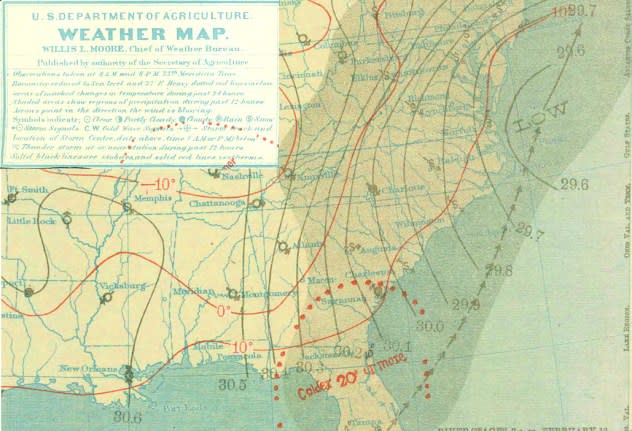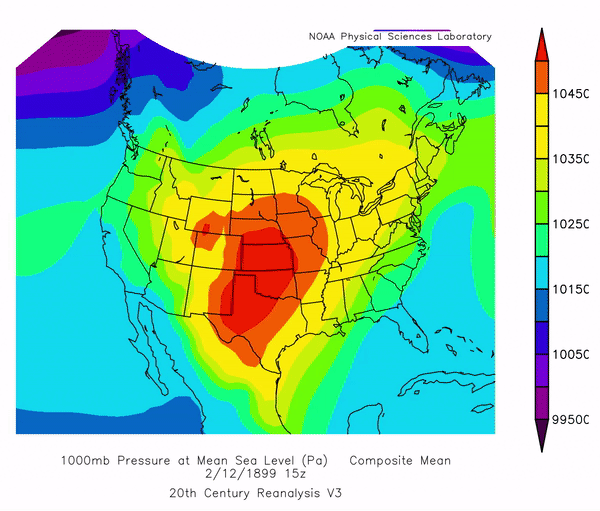'Snow King' Blizzard, Arctic outbreak still unmatched 123 years later
 |
Piles of snow were stacked higher than horses in New York City following the Great Blizzard of 1899. (Library of Congress) |
Nor'easters, bomb cyclones and blizzards are some of the words used to describe powerful East Coast snowstorms, but more than a century ago, a storm of colossal proportions blasted the region and solidified its place in history as the Snow King.
The Snow King, also known as the Great Blizzard of 1899, embodied the term "historic" with snowfall totals and extremely low temperatures that are still etched in record books across the country to this day.
The predecessor of the National Weather Service, the Weather Bureau, called it "a snowstorm of unprecedented severity in the Middle Atlantic States" that was accompanied by "a freeze that for duration and severity stands unparalleled."
The everyday life in America when the storm hit was significantly different than it is today with the 1899 blizzard arriving four years before the Wright Brothers took flight at Kitty Hawk, North Carolina, and nine years before the Ford Model T was manufactured for the masses.
 |
Horses pull carts filled with snow in New York City after the Great Blizzard of 1899. (Library of Congress) |
The wrath of the blizzard pummeled the mid-Atlantic between Feb. 11 and Feb. 14, 1899, with 20 to 30 inches of snow accumulating from central Virginia to western Connecticut, including 20.5 inches in the nation's capital. This still stands as the second-biggest snowstorm to hit Washington, D.C., behind only the Knickerbocker storm of 1922. Cape May, New Jersey, recorded nearly a yard of snow, with 34 inches piling up in the popular beach town.
Snow drifts turned into mountains taller than the horses and carriages that tried to navigate the 19th-century streets, causing virtually all transportation across the region to shut down.
The mammoth blizzard spread snow far beyond the mid-Atlantic with snow reported as far south as Fort Myers, Florida. As much as 3 inches of snow accumulated in the Florida Panhandle with enough snow piling up in Tallahassee for residents to have snowball fights.
 |
A snowball fight in Tallahassee, Florida, after the Great Blizzard of 1899 spread accumulating snow across the Florida Panhandle. |
As impressive as it was, the monster snowstorm almost seems like a footnote compared to what unfolded in the wake of the storm.
The term "polar vortex" does not exemplify the severity of the brutally frigid air that engulfed North America behind the blizzard, an invasion of cold weather that became known as the Great Arctic Outbreak of 1899.
The extremity and duration of the cold sound more like fiction than fact with icy air initially sinking across the western United States on Feb. 4 and maintaining an icy grip on the country through the middle of the month.
Sub-zero temperatures were reported in all 45 states across the U.S., including a teeth-chattering 2 degrees below zero F in Tallahassee. This is the only time in recorded history that the temperature dipped below 0 F anywhere in the Sunshine State.
 |
The U.S. Department of Agriculture's Weather Bureau Weather Map for Feb. 13, 1899 shows a large low pressure system bringing snow from South Carolina to Maine, with temperatures in the Florida Panhandle dipping into the teens and the freezing line (32 F) two-thirds of the way through Florida. |
The sharp cold front that ushered in the record-setting chill did not stop after sweeping across the U.S. There were reports of intense waves crashing into Cuba as the cold front stirred up rough seas, which washed away some buildings near the beaches.
All-time low temperatures that were set in towns across the central and eastern U.S. during the Great Arctic Outbreak of 1899 still stand more than a century later.
The mercury plummeted to 61 degrees below zero F in Fort Logan, Montana, the lowest temperature recorded during the historic chill. This was just 9 degrees shy of the lowest temperature ever measured in the contiguous U.S. set in Medicine Lake, Montana, on Jan. 20, 1954.
Temperatures of 20 to 30 degrees below zero were common across the Nation's Heartland with the widespread, long-duration cold creating a phenomenon that has been witnessed only a handful of times.
 |
This animation from the 20th Century Reanalysis (V3) project shows estimated mean sea-level pressure in the U.S. between Feb. 12 and Feb. 14, 1899. The strong low pressure system off the east coast (purple is lower pressure) is the "Snow King" storm. |
The Mississippi River froze with ice, either floating or solid, throughout the entire Mississippi River watershed, according to a "Monthly Weather Review" from the Weather Bureau.
"On February 17, ice was even witnessed flowing down the Mississippi River, past New Orleans, and into the Gulf of Mexico," NOAA said. The ice on the mighty Mississippi and across the Great Lakes "completely halted barge traffic."
F.P. Chafe worked in Montgomery, Alabama, for the Weather Bureau, wrote that "streams that were never known to freeze before were covered with ice."
CLICK HERE FOR THE FREE ACCUWEATHER APP
 |
The Weather Bureau issued timely and accurate warnings of the cold before its arrival, helping countless people brace for what was set to unfold. Still, the unprecedented nature of the cold took its toll.
In Chicago, sub-zero low temperatures were recorded for a week straight, including a stretch longer than 48 hours where temperatures remained below 0 F. The duration of the extreme cold caused underground water and gas lines to rupture, overwhelming plumbers and city workers.
In a review of the brutally cold weather, the Weather Bureau wrote, "great suffering was caused by the severe cold among the poorer classes, and many people were frozen to death."
More than 100 fatalities were reported across the country associated with the cold weather, as well as millions of dollars in damage to crops and livestock, according to NOAA.
 |
Ice covers oranges that were sprayed with water during an overnight freeze in Apopka, Fla., Thursday, Jan. 7, 2010. The trees are sprayed with water during the night and into the early morning hours to insulate them from freezing.(AP Photo/John Raoux) |
Entire fields of crops were decimated across the Gulf Coast states due to the unprecedented chill.
"The early vegetable crop was entirely destroyed; the orange crop was a total loss, and trees were killed. The cane crop was considerably injured, and fruit, aside from oranges, was seriously injured," said Alexander G. McAdie, who worked in New Orleans for the Weather Bureau.
In the long term, the historic Arctic outbreak was one of multiple cold snaps in Florida that ultimately forced citrus farmers to abandon areas around Jacksonville and St. Augustine and to plant groves farther south in the state, according to the Florida Climate Center.
Florida's temperature-sensitive crops are still not completely immune to freezing air. Arctic air pays the Sunshine State a visit every few years, and while it is typically far from the extremely low temperatures experienced in 1899, it does raise concerns for citrus growers as well as the cold-blooded iguanas of southern Florida.
For the latest weather news check back on AccuWeather.com. Watch the AccuWeather Network on DIRECTV, Frontier, Spectrum, fuboTV, Philo, and Verizon Fios. AccuWeather Now is now available on your preferred streaming platform.








